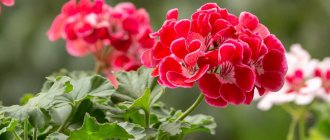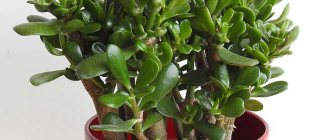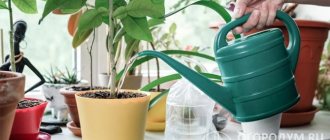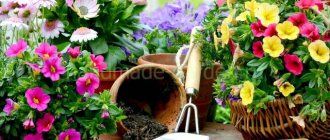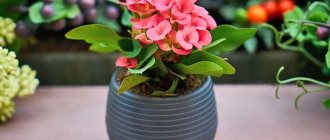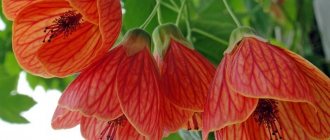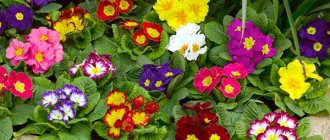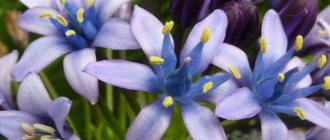Sun-loving perennials for the garden are responsible for the positive mood of dacha owners and delight neighbors and passers-by with their blooms. When creating sunny flower beds, it is required that the inhabitants of the flower bed do not lose a portion of sunlight. The correct combination of crops and selection of growth are valued. This way, tall individuals will provide short specimens with a successful background. When creating a flower garden in the sun, what to plant from perennials is not an idle question for gardeners.
Distinctive features of perennial crops include:
- decorativeness;
- duration of the growth period;
- there is no need to sow and replant for several years.
On a note. During this time, green plantings retain their decorative properties. Most perennial plants are easy to care for and bloom earlier than annuals.
Sun-loving perennials
Scope of application of perennial flowers:
- hanging flowerpots;
- volumetric garden figures;
- floral sculptures for site decoration;
- multi-storey landscape objects.
On a note! The greenery of planting sun-loving flowers for the perennial garden, blooming all summer, when decorating the front garden will serve as a plan for other crops or as a decorative application. They complement each other perfectly due to differences in color, shape and size.
Choosing perennials
Summer residents note the benefits of growing perennials:
- Preserving the beauty of the flowerbed for a long time.
- The grade of a flower bed affects the time frame of its existence. In addition, there is no need to replant and sow rockeries or mixborders.
- The winter hardiness of perennials guarantees that plants can overwinter in the garden without special protection. In addition, crops bloom much earlier due to the development and strength of the roots.
- Minimum expenses for the annual flowering of the flower bed.
What plants love the sun?
The choice of plants that do well in open spaces is extensive. Without additional measures, constant sun is well tolerated by the following representatives of the flora:
- Succulents. A group of plants native to arid areas. Their common feature is the ability to store moisture in the fleshy leaves.
- Species with pubescent leaves (for example, Anaphalis). The edge is a protective mechanism that reduces moisture loss.
- Many bulbous plants. The rhizome bulb stores enough water and nutrients to withstand the heat.
- Plants whose leaves and stems are bluish or silver in color (the characteristic is often supplemented by a feathery edge or a waxy coating). The unusual color prevents the leaves from overheating; it is characteristic, for example, of many varieties of wormwood and cloves.
Schmidt's wormwood is not afraid of constant sun Source sazhaemvsadu.ru
- Species with degenerate (small, narrow) leaves: most conifers, acacia.
- The species are native to steppe and desert zones; in our gardens these are, as a rule, cereal herbs with narrow, long leaves.
Among all this diversity, summer residents and amateur gardeners give preference to perennials, since drought-resistant perennials have the following growing advantages:
- Plantings and flower beds remain decorative for several seasons.
- You don’t have to renew and replant your mixborder or rockery every year.
- Most perennials are winter hardy; they do not need special protection during wintering.
- Perennial crops have a well-developed root system; many species bloom early and have a long flowering period.
- Annual flowerbed care does not require a lot of effort, time and finances.
Picturesque bryozoan (Irish moss) among the stones Source greenmarket.com.ua
See also: Catalog of companies that specialize in designing and performing landscape work of any complexity
Flowers for a sunny garden
Long-flowering perennials for the garden
Summer residents are interested in which flowers are best to plant in sunny flower beds in the fall. Perennials grow well when sown before winter:
- Viola. Almost every gardener is familiar with another name for the plant - pansy. Low-growing crops are characterized by a rich range of colors: blue and white, yellow and black, spotted red. The culture loves fertile soil - loam, without stagnant moisture, and is responsive to frequent fertilizing with saltpeter and superphosphate. Fresh manure is prohibited. To prolong flowering, get rid of the seed pods.
Viola
- Astilbe. A herbaceous perennial from the Kamnelovaceae family, it varies in size: from dwarf to tall. The culture is crowned with paniculate inflorescences of different colors. The plant likes growing in rich humus soil, regular watering, and eliminating flower stalks at the end of flowering. To protect from frost, bare roots are covered with spruce branches or agrofibre.
- Hyacinths. When caring for flowers, it is important to apply fertilizers in a timely manner, especially dry ones, immediately when the first shoots form. At the same time, the soil is loosened. At the budding stage of hyacinths, a second root feeding is carried out with liquid fertilizer. If the plants have flowered, it is time to carry out the third feeding. You will need to moisten the soil while the bulbs take root. During drought, shoots are watered abundantly.
- Delphinium. Seeds are planted in autumn or spring. Practice seeding density for a luxurious flower garden. The bed is sprinkled with a 4 mm layer of soil. Types of delphinium: holostem and Persian, hybrid and large-flowered. The crop needs systematic watering, which is combined with careful loosening of the soil.
On a note. Proper root irrigation of delphinium will protect against the development of powdery mildew.
- Nivyanyk. Other names for white chamomile, popovnik, roman herb, white flower. White chamomile will decorate a plot outside the city. The unpretentious culture is frost-resistant. Popovnik grows in one place for up to 7 years, if you properly care for the plant.
- Peony. The light-loving crop likes loose soil. The plant can grow in the garden for more than 25 years. When planting, take into account that the peony does not tolerate drafts and grows strongly. A close distance from the wall of the house is not the best place for planting: excessive rainfall will provoke rotting of the root system.
- Rudbeckia. Looks like chamomile. The petals have different colors: yellow and lemon, orange and brownish. The culture is not demanding on soil. Rudbeckia feels good on moist, well-groomed soil. Responds to fertilizing with nitrophoska and potassium sulfate.
- Chrysanthemum. Plant growth varies from 35 cm to 1.5 m. The bushes have a variety of colors and shades.
- Kniphofia. The African guest has successfully taken root in Russian summer cottages. The height of the exotic is 120 cm. The spike-shaped inflorescence of the plant looks like a huge two-colored cone. The flower is friends with sedum, echinacea, and yarrow. Perfectly shades short sun lovers.
- Turkish poppy. The crop grows without replanting for several years on any type of soil. Poppy petals are painted in scarlet and pink tones. There are also varieties with orange and snow-white shades. The poppy blooms in the last ten days of May and the first days of June.
Turkish poppy
4 varieties of herbs that don't need to be watered
For some reason, some gardeners underestimate herbs. But they are the ones who are able to create a beautiful and bright green background for a flower garden, flower bed or any other planting - be it in the garden, front garden or vegetable garden. We bring to your attention several cereals that, being completely undemanding and not capricious, will certainly become the highlight of your landscape design.
All of the herbs listed below are grains. Cereals have two undeniable advantages. Firstly, they can take root in any corner of your dacha. Even in areas where other plants flatly refuse to develop. And secondly, cereal grasses are not at all afraid of pests. Diseases are also not scary for them. This attack rarely affects cereals in single plantings.
- The meadow is winding.This is the same plant that, once on your site, forms green hummocks. If you use meadow grass correctly in landscape design, it can be made a real highlight of your dacha. Moreover, this cereal is not afraid of either drought or frost. It tolerates summer heat perfectly even without watering. The same thing happens with frosts: the meadow grass easily overwinters in the ground without additional shelter, and with the arrival of spring it begins to form green hummocks again. Another advantage of this plant is that the meadow does not make any special demands on the soil: you can plant it in any soil, even if such soil is not suitable for other plants.
- Thin-legged gray.This representative of cereals got its name due to its thin and long foliage, as well as its color: the leaves of the thin-legged plant are green, but at the same time they seem to be covered with a bluish coating on top. This gives the impression that the green in the leaves is muted by a small amount of silver. The thin-legged plant looks amazing in a flowerbed and in other plantings. But it does not require specific care. Apparently, it is precisely for this and for its appearance that the thin-legged plant fell in love with flower growers all over the world, including Ukrainian ones.
- Reed canary grass.Long and bright leaves with a white color are the main advantage of the canary plant. This grass is often used to decorate flower beds and areas along artificial or natural reservoirs. This is an excellent accent plant that does not need regular watering. In addition, the canary does not care where it grows. This can be absolute shadow or the most sunny location. Both under the dense canopy of trees and under the scorching sun, the canary feels quite comfortable.
- Tenacious.There are a huge number of varieties of survivors known. The main difference between varieties is the color of the flowers. Therefore, you can choose the survivor that suits you best in color scheme. The name of this plant speaks for itself: the tenacious plant will easily survive under any conditions. This is the “last hero” among the flowering representatives of the flora. By the way, this is why the tenacious plant can often be found in fields and wild meadows - where cultivated plants cannot survive.
Drought and heat tolerant perennials
Important! Living in the city and infrequent visits to the dacha only on weekends or holidays are fraught with moisture deficiency, which perennials will feel in the dry and hot summer season.
Unpretentious and long-blooming perennial flowers for the garden
Drought-resistant flowers for a flower bed in a sunny area will solve the problem. There are many drought-resistant plants for the garden, including perennials. These are drought-resistant plants, bushes and trees that grow in the sun with insufficient watering.
Groundcovers are drought-resistant perennial flowers that bloom all summer and decorate sunny beds.
Interesting! Ground cover plants are indispensable if you need to camouflage a hopeless area where nothing wants to grow under the scorching rays of the sun and when there is a lack of watering.
Among the heat-resistant flowers for the flower bed are:
- Sedum. Includes representatives of succulent perennial plants that are attractive in appearance and require almost no watering. Succulents obtain water from the air and accumulate it in the thickness of the foliage. Plant growth occurs rapidly, problem areas disappear quickly.
Popular varieties of ground cover plants include:
- false and caustic;
- white and bent;
- Kamchatka and Lydian sedum.
- Irish moss. A dwarf perennial that will ideally fill gaps between tiles or stones, paths in a sunny area. You will need to water the plantings immediately after planting. Tolerates any weather conditions: heat and frost, light and rain. The peak of bryozoan decorativeness falls in July, when the crop blooms with miniature delicate flowers. The plant is resistant to trampling.
- Chistets woolly. The culture is popularly called hare or sheep ears. The drought-tolerant perennial has oblong leaves that appear covered in silver-gray fur. When flowering, the chistets appear blue, pinkish or lilac flowers, which are collected in an inflorescence in the shape of a spike.
Important! To give the perennial a decorative appearance and avoid a sloppy appearance, the chickweed is pruned short at the beginning of the growing season.
- Phlox subulate. Creates a huge pillow of small, needle-like leaves. The heat-resistant perennial blooms at the end of spring. Numerous small flowers of various shades cover the bush. Plantings are carried out on sunny rockeries or hills, which are bordered by low borders.
- Monetary loosestrife. The crop likes to be watered, but it does well without watering. When there is no periodic watering, loosestrife with yellowish-colored leaves in the sun becomes more saturated in color. The perennial looks great on slopes, hills, and also as a grassy lawn cover.
Monetary loosestrife
- Gypsophila. Perennial flowers among drought-resistant plants will help maintain a good mood for a long time. Tumbleweed, as it is popularly called, belongs to the Clove family. The growth of the branched stem is 20-50 cm. The flowering period of gypsophila falls at the beginning of June and lasts until the weather gets colder. Snow-white pink flowers that gather in paniculate inflorescences resemble an airy cloud. The crop is propagated by seed, directly into an open garden bed.
- Daylilies. They are unpretentious and drought-resistant. The foliage is pleasingly decorative after flowering. The variety of daylilies is amazing in size and color. Today, Russian breeders are working on developing remontant (blooming again) varieties.
- Yarrow. Nowadays it is easy to buy highly decorative plant varieties with different colors. The culture is unpretentious in care. Reproduction of yarrow by self-sowing leads to clogging of the garden plot and is a problem for summer residents. Prefers the sunny side of the flower garden.
Yarrow
- Spurge. The perennial is able to withstand drought for a long period. Euphorbia is used to decorate a hill or rock garden. A plant suitable for borders, tall varieties serve as a focal crop for a sunny flowerbed.
The following varieties of milkweed are popular among gardeners:
- multi-flowered and fringed;
- almond-shaped and capitate;
- cypress.
- Gatsaniya. A distinctive feature of a flower that pleases in summer is its wide color palette. Therefore, many designers call the plant a chamomile from South Africa.
Important! Gazania has 40 varieties that grow in warm climates. Some species are grown in cold areas, however, as an annual crop.
Due to the ease of care, the crop is cultivated:
- in pots;
- in rock gardens;
- in containers on the loggia;
- as a border.
Sunny plot: how to take into account its pros and cons
An open, sun-filled space suits many plant species. Warm-loving crops warm up well, which is important for their proper nutrition and growth. The role of the sun as a natural disinfectant is also important: it dries the leaves and prevents moisture from stagnating on the soil surface. All together reduces the likelihood of putrefactive processes and the appearance of fungal diseases.
However, even for plants that love the sun and heat, the conditions of a sunny lawn near the house may be unfavorable. Therefore, before planting plants in the sun, it is necessary to rely on the following options:
- Intense sun dries out the soil and causes leaf burns; In dry and hot summers, even heat-loving crops can suffer.
- An open area can be made more comfortable if you supplement it with an automatic watering system. Thoughtful humidity control will allow you to expand the range of crops grown and create more diverse compositions. However, any system should be used only before sunrise or late in the evening to prevent water droplets on the leaves from causing burns.
Alpine slide on a personal plot Source green-battery.ru
- A fountain is a suitable solution for a sunny place; it will not only humidify the air, but will also become a highlight of the landscape. A small solar-powered fountain is suitable for arranging a constantly illuminated area. You just need to position it so that the wind does not blow splashes onto the plants and does not over-moisten them.
- A decorative pond can also increase humidity. But the pond has a disadvantage: aquatic plants grow intensively in the sun, and if they are not thinned out, the pond will quickly turn into a swamp. Organizing artificial water movement will help combat the growth of underwater flora and flowering on the surface.
- In spring, snow melts early on open plots, and plants may be defenseless against spring frosts. It is necessary to take care of well-ventilated shelters (ventilation is needed to avoid the greenhouse effect, when plants can get wet).
- Many sun-loving perennials do not tolerate the temperature contrast between day and night (in central Russia it can be significant even in May or August). The solution may be to select zoned (suitable for a given region) varieties.
Gray fescue is one of the drought-resistant species Source na-dache.pro
- Particularly delicate varieties can be planted near the house: during the day, the surface of the wall accumulates heat and releases it at night. Large stones have the same ability, so it is good to arrange a rockery under the sun.
- Heat-loving crops, as a rule, do not tolerate drafts well. Protection will be the wall of the house, a hedge or a bush planted in the right place.
Decorating a flower bed in the sun
In order for a flowerbed in the sun to have a unified style, choose what to plant. In addition, the flower garden must comply with the rules:
- Minimalism. Plant a maximum of 3 varieties of plants per 1 m2 of area.
- Long-lived crops are preferable.
- The soloist occupies the central place and dominates the flowerbed.
- Color palette. The tones determine the style, thematic idea and wishes. The softness of the colors enhances the beauty of individual crops. The combination of blue and white shades has the effect of glowing from within, the violet-blue color gives off coldness and nobility, the pink tone gives off romanticism, the red-yellow color is responsible for the audacity and brightness of the images.
Perennial flower bed
- Foliage is valued no less than flowers. Most of the crops are decorative and remain attractive with the arrival of the autumn season.
- Maintaining optical balance, softening contrasts.
- Spontaneous decisions are welcome.
- They prevent perennial crops from going wild and rejuvenate old bushes.
- Viability of perennials in the flower garden. Partners should not suppress each other.
- Candidates for the flower bed are selected according to the growing conditions.
- Follow the requirements for landing a single individual.
- Plan the design of the edge of the flower bed in advance. Low-growing varieties that cover clearings are suitable. Geranium, dwarf spirea, lungwort, and heuchera will help out.
Perennials for the garden, blooming all summer
Schemes of simple flower beds are:
- Permanent compositions with a clearly defined geometric pattern, where crops bloom at the same time and are separated from each other;
- Non-permanent compositions in which crops are grouped and the flowerbed fits into the garden decor. The order of flowering of perennials will increase the decorative life of the flower bed.
On a note! Regardless of the form, there is a main pattern in planting plants in a flower garden. In the center there are flashy and tall specimens, the middle part is the location of medium-sized specimens, and low perennial long-flowering plants or ornamental grass take place on the edge.
Caring for a flowerbed on the sunny side
To provide care for a flower bed of perennials in a sunny place, you will need:
- water the plants periodically and promptly;
- loosen the soil and remove weeds;
- prune faded crops and faded flowers;
- apply fertilizing.
Important! Agrotechnical techniques will help preserve decorative properties, promote the splendor and duration of flowering, provide the required nutrition and resistance to harmful insects and phytodiseases. The timing of fertilizers affects the health of perennials. It is recommended to feed the plants comprehensively, at least twice a month, with a break of 2 weeks.
Creative imagination and desire will turn an ordinary flower garden into a masterpiece. To create an extraordinary flower arrangement, 1 m2 of space is enough. Sun-loving crops are planted on the plot of land, which cope with the prolonged heat and make the garden attractive.
0 0 votes
Article rating

